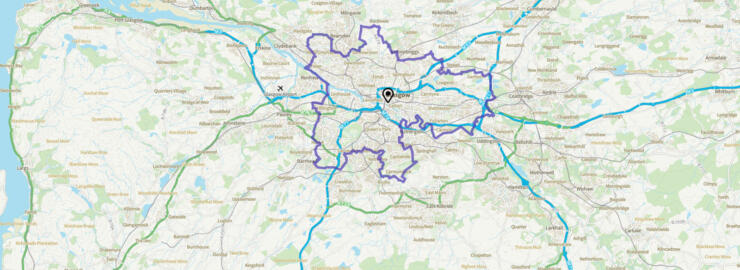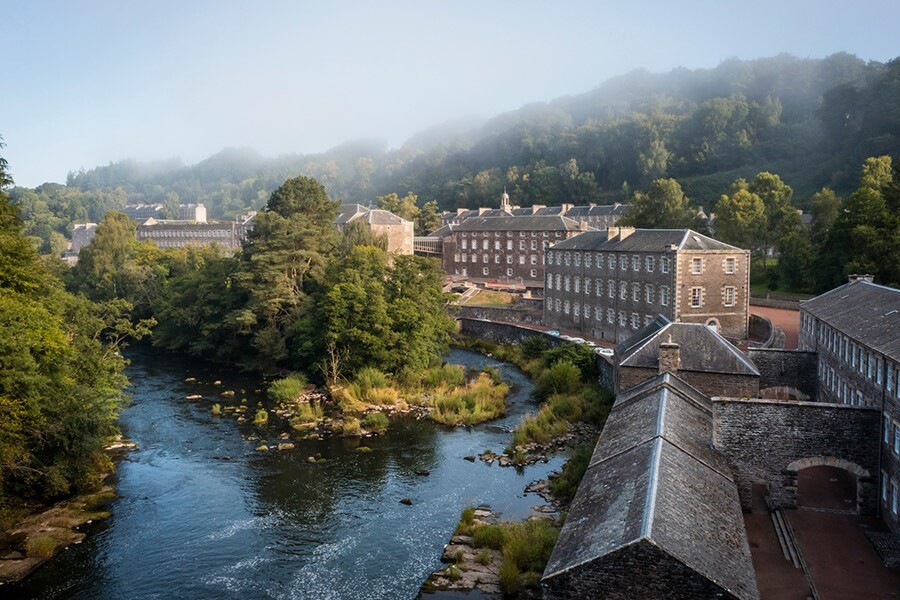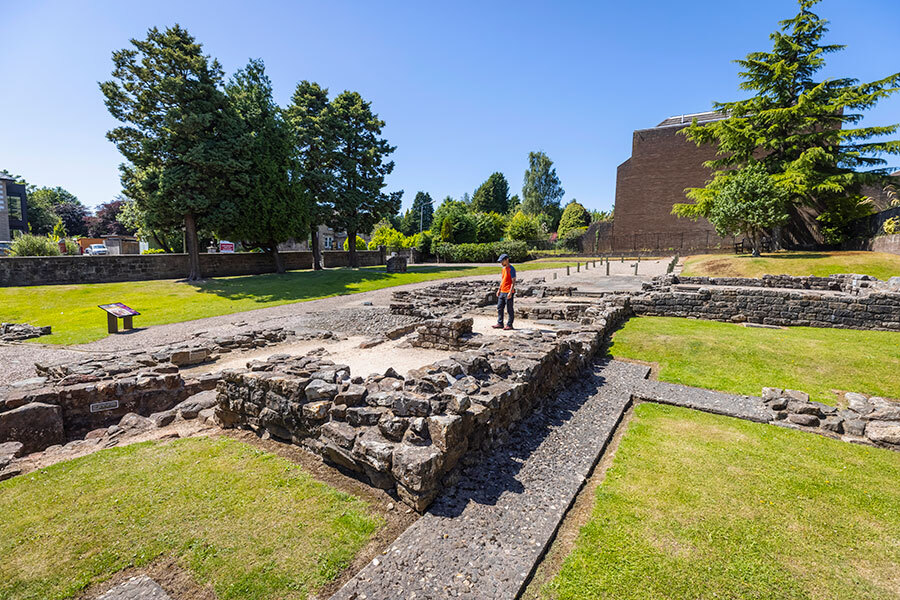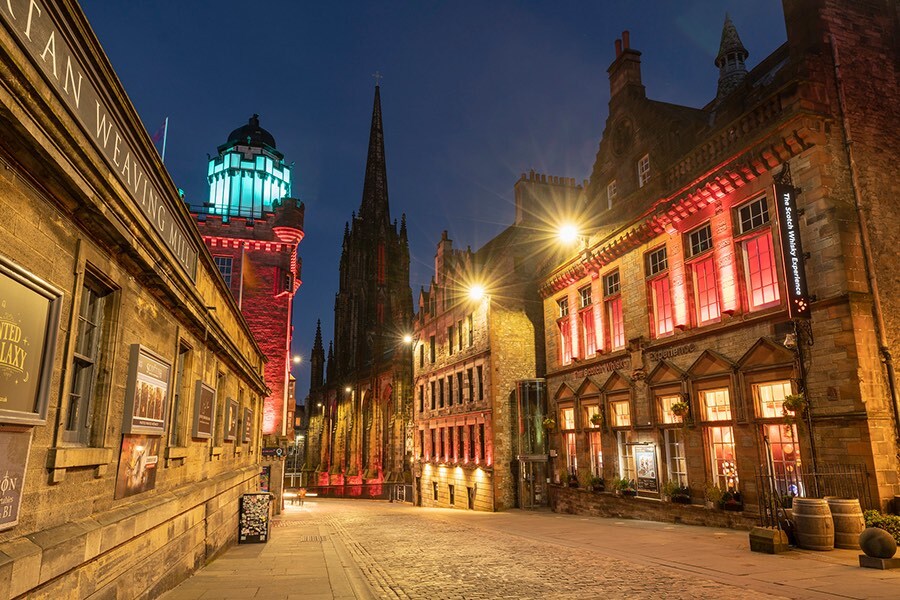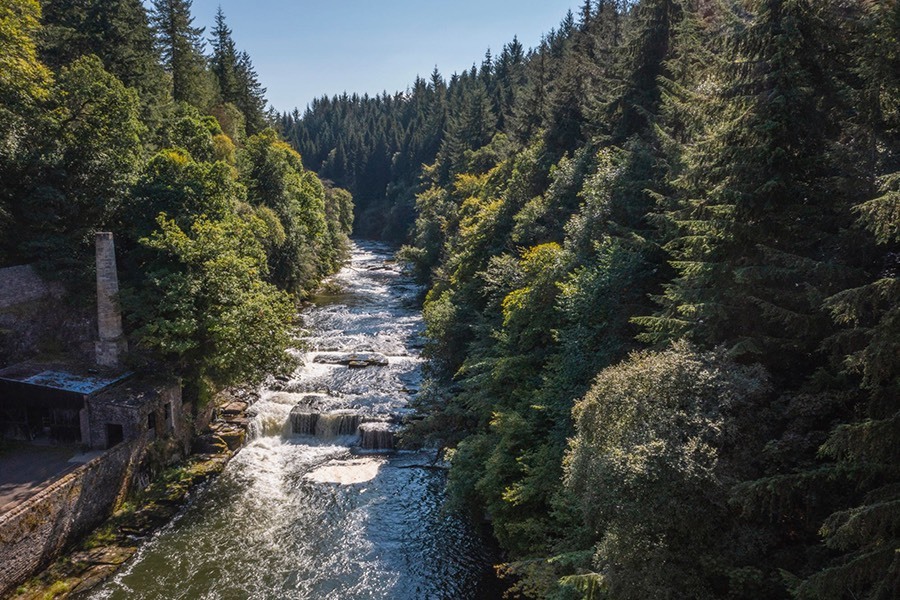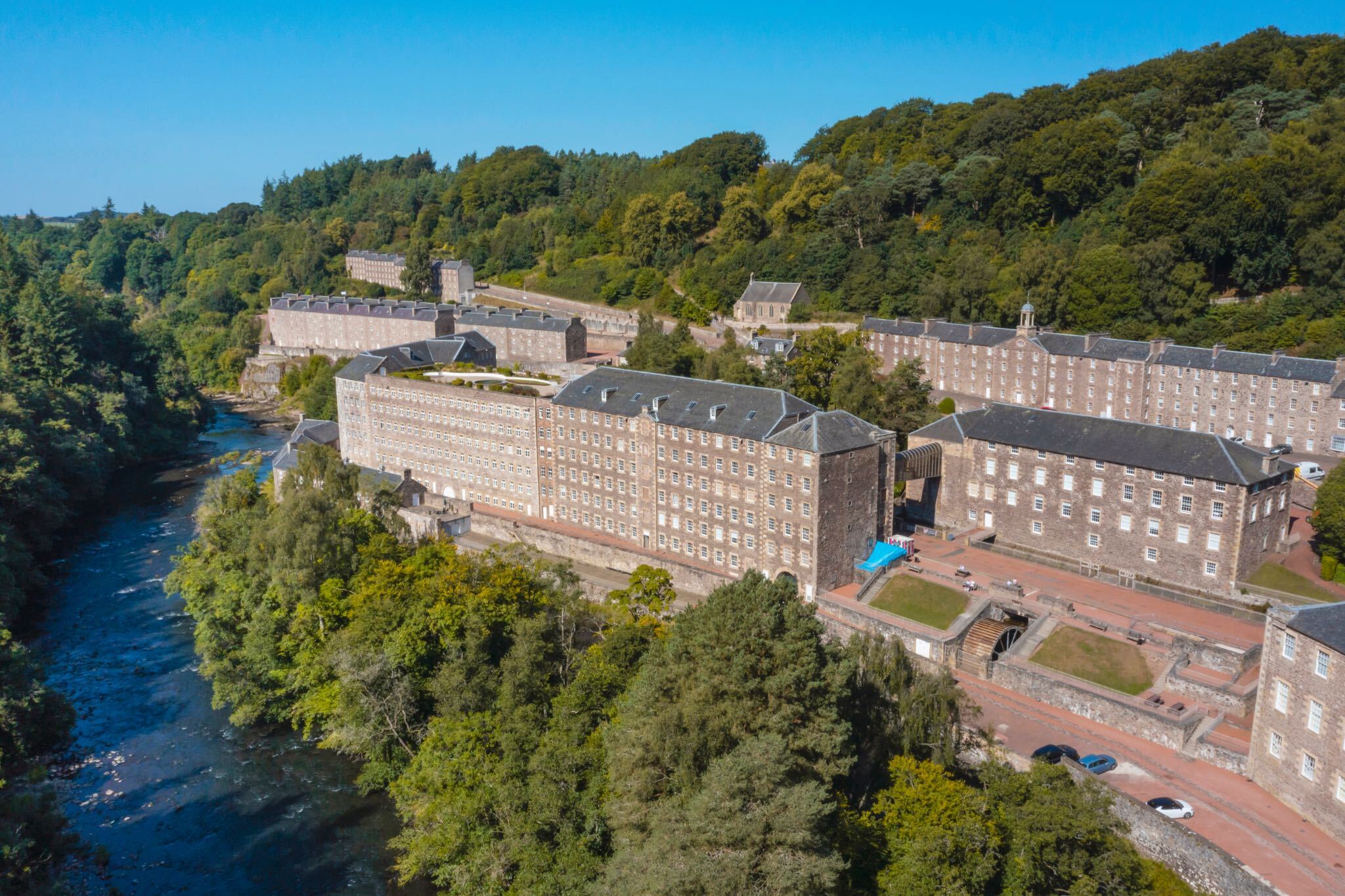
Discover & Experience UNESCO Sites to Explore in Central West Scotland
How to get to the west of Scotland
The west of Scotland is easy to reach. You can hop on the train at stations across the UK and arrive in either Glasgow Queen Street or Glasgow Central stations. From there you can then explore the west of Scotland by rail, bus, or coach, or from the comfort of a rental car.
If you do rent a car, consider opting for an EV model. You can collect it in Glasgow before setting off on a carbon-neutral road trip through the west of Scotland.
Glasgow Airport serves more Scottish destinations than any other airport and provides connections to and from a wide array of destinations throughout the UK and Ireland. It is also Scotland’s largest long-haul charter hub and serves over 100 destinations worldwide, including Europe, North America, the Caribbean, and the Middle East.
Offering links to London airports including Gatwick and Heathrow, it couldn’t be simpler to arrive in the UK and fly from there straight to Glasgow.
Find more information and advice on travelling to Greater Glasgow & The Clyde Valley.

Glasgow UNESCO City of Music
Where to start
Glasgow is Scotland’s largest city and famous for its world-class visitor attractions, impressive architecture, sprawling parks and public gardens, buzzing nightlife, and multi-cultural food and drink offerings. Despite its size, Glasgow is surprisingly easy to get around, boasting its own Subway as well as an extensive bus network and on-street bike hire.
Why not start in the city centre, George Square, and plan your route around this amazing city? It’s also the starting point of the City Sightseeing Bus Tour, which takes you around the key attractions letting you hop on and off all day.
Neighbourhoods to base yourself in
- Merchant City
- Finnieston
- Kelvingrove
- Dennistoun
Why it’s special
Glasgow has long been popular for its lively pubs and clubs. But what really gives the city its edge is its legendary live music scene, regarded as one of the biggest and most vibrant on the planet. From vast venues like The OVO Hydro to hallowed spots like King Tut’s Wah Wah Hut, Glasgow is an essential tour stop for every major and up-and-coming artist in the world, as well as a place of beginnings for unknown musicians. Filled with venues of all shapes and sizes, prestigious musical academies and institutions, and independent record shops, with a busker never out of earshot, music reverberates through the entire city quite unlike anywhere else.
Did you know up to 130 shows have been known to take place in Glasgow in a week?
Type of designation
UNESCO City of Music
How long to stay
At least 2 days
What to do during your time
Things to do
Glasgow Music City Tour
Music journalist Fiona Shepherd has been attending and writing about gigs for over 30 years. Join her or one of her fellow knowledgeable guides on a walking tour tracing the evolution of Glasgow’s legendary music scene. Follow in the footsteps of iconic bands, DJs and other performers who have made their mark in Glasgow and step inside fabled venues like the Barrowland Ballroom and the Britannia Panopticon Music Hall, the world’s oldest surviving music hall.
Find out more about Glasgow Music City Tour.
People’s Palace
Located in Glasgow Green, the city’s oldest park, the People’s Palace is an impressive museum which charts the human story of Glasgow, from the mid-18th century to the present day, through fascinating artefacts and imaginative, family-friendly installations. Built in the 19th century, the palace was originally built as a cultural centre for the inhabitants of the city’s impoverished East End.
Explore the People’s Palace.
Some Great Reward
Set in the Queen’s Park area of the Southside, Some Great Reward is one of the city’s favourite vinyl stores. Impossible to miss with its striking pink and purple store front, this record store and café takes its name from the classic Depeche Mode album. Peruse a staggering collection of vinyl including the latest new releases and enjoy a cup of locally sourced coffee with a homemade vegan treat on the side.
Discover more record stores in Glasgow.
King Tut’s Wah Wah Hut
Ever since it opened its doors in 1990, King Tut’s has been a rite of passage for indie bands on their way to rock stardom. The Verve, Pulp, Radiohead, and Manic Street Preachers have all played career-making gigs here. It’s also where Oasis were famously discovered and signed.
Decades on, it remains an exciting platform dedicated to showcasing emerging talents alongside established acts.
Find out more about King Tut’s.
The Glasgow Royal Concert Hall
This elegant 2,000-seat concert hall is located at the heart of this musical city. It regularly hosts a sparkling array of pop and rock superstars alongside some of the world’s most acclaimed classical artists. It’s also the home of Scotland national orchestra, RSNO, and you can enjoy a range of smaller intimate concerts in the City of Music Studio and a series of ‘break-out’ spaces.
Since opening in 2015, the venue’s New Auditorium with its state-of-the-art acoustics has become one of the city’s most exciting spaces for performers and artists alike.
The Glasgow Concert Halls includes the Royal Concert Hall, as well as the Old Fruitmarket and City Halls which together provide a traditional setting for all types of music.
Find out more about the Glasgow Royal Concert Hall and other concert halls in Glasgow.
City Centre Mural Trail
Explore the alleyways and side streets of Scotland’s biggest city and discover some incredible murals created by talented locals. Designed to revitalise the forgotten corners of the city, the Glasgow City Mural Trail brings together thought-provoking public artworks that expose visitors to different perspectives of the city they might not have uncovered otherwise.
Find out more about the City Centre Mural Trail in Glasgow.
Òran Mór
Set inside an imposing converted church with a towering spire in the fashionable West End, Òran Mór boasts a beautiful upstairs auditorium with a vivid mural created by celebrated artist and author Alasdair Grey. Most of the gigs are held in the intimate crypt-like basement which also serves as both a refined nightclub and cosy lunch spot during the daytime.
Find out more about Òran Mór.
The OVO Hydro
With its 14,500-seat capacity and state-of-the-art facilities, all purpose-built for entertainment, The OVO Hydro has become one of the world’s top five busiest venues. Attending an event here is a unique experience due to the shape of the arena, which creates a truly intimate atmosphere enveloping the full audience. The OVO Hydro and neighbouring Armadillo were both designed by world-renowned architects Foster and Partners and are etched onto the Glasgow skyline.
Check out what’s on at The OVO Hydro.
Music events & festivals
Glasgow has the stage for an array of music festival events spanning practically every genre imaginable. Whether you’re a devotee of traditional Scottish folk music or love nothing more than an evening of jazz, there’s an event to suit your musical tastes. Some of the festivals include Celtic Connections, the Glasgow International Jazz Festival, Piping Live! Festival, the World Pipe Band Championships, TRNSMT Festival, Glasgow Summer Sessions, Summer Nights at the Bandstand, and more.
Discover more music events and festivals in Glasgow.
Glasgow club scene
Glasgow’s music can be found right into the night, with clubs such as Sub Club and The Berkeley Suite a hit with music fans every week. SWG3 has been hailed as putting Glasgow in line with the likes of Berlin and New York.
Check out this previous Guardian article for an idea of what club life is like in Glasgow.
Food & Drink
The choice of places to eat and drink in Glasgow is second to none. With cafés, bars, and restaurants around every corner spanning everything from vegan dishes to international cuisine, there is something to tantalise all palettes.
- Mono
- The Piper’s Tryst Restaurant at the National Piping Centre
- Alchemilla
- Café Strange Brew
- Platform
- Mother India
Accommodation
Relax and rewind after exploring all the city has to offer in one of many excellent accommodation offerings. From high-end hotels and characterful guest houses to self-catering apartments and more, the choice on offer is outstanding.

Walks and ways to travel around
Glasgow is spoilt for choice when it comes to beautiful walks and places to stroll. With over 90 parks and gardens, it is no wonder that the city’s name derives from the Gaelic word Glaschu, which translates as the ‘dear green place’.
Explore Kelvingrove Park in the West End and take in the stunning Botanic Gardens, home to the Kibble Palace, a Victorian glasshouse with an extensive tropical plant collection. In the East End is Glasgow Green, the city’s oldest park which plays host to the World Pipe Band Championship. On the southern outskirts of the city is Pollok Country Park, the city’s only country park which has a resident herd of Highland cattle.
Did you know?
Glasgow introduced Scotland’s first ever low emission zone in 2018 – the current zone covers all local service buses, while the second phase will apply to all vehicles.
First Bus Glasgow has 150 electric buses.
More information
UNESCO designation
Glasgow UNESCO City of Music People Make GlasgowVisiting the area
Glasgow Glasgow iCentre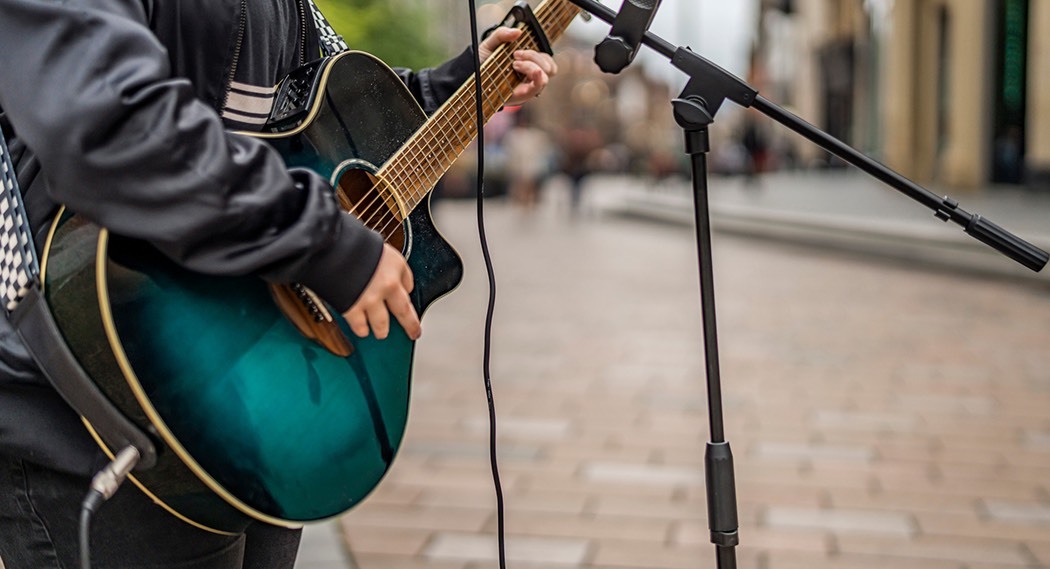

New Lanark UNESCO World Heritage Site
Where to start
The award-winning New Lanark Visitor Attraction at the New Lanark UNESCO World Heritage Site brings to life the engrossing story of this purpose-built 18th century cotton mill village, which was powered by the River Clyde. Beautifully restored, visitors from around the world are invited to set foot in the past and learn about aspects of modern, civilised life which were pioneered here and that we now take for granted.
From homes designed for workers which would set the standard of living conditions for centuries to come, to the world’s first-ever kindergarten, New Lanark serves as a time capsule of a community at the forefront of some of the greatest social and industrial changes in Europe.
Nearby cities/towns to base yourself in
Why it’s special
The 18th century mill village of New Lanark was created by Glasgow banker and entrepreneur David Dale, and developed further by his son-in-law, philanthropist and social reformer Robert Owen. It became a world-renowned blueprint for what could be the ideal working and living environment for workers and their families. Inspired by the progressive values of the Enlightenment, New Lanark was their mission to show that rather than hindering industrial productivity, prioritising the well-being and advancement of the working class could improve it.
New Lanark presented a progressive new model of community with many of the ideas and initiatives developed here now widely accepted features of contemporary society today, from town planning and free education, to social security and even street lighting.
Type of designation
UNESCO World Heritage Site
How long to stay
At least 2 days

What to do during your time
Things to do
New Lanark Visitor Centre
Annie McLeod Experience
Explore the many attractions and exhibition areas of New Lanark Visitor Centre with a passport ticket, beginning your visit with the Annie McLeod Experience. Sit in your motorised pod and watch as a vision of a mill girl named Annie from 1820 appears before you to share the story of her life in New Lanark.
People & Cotton Experience
This exhibition explores production and working conditions in the cotton industry, from the cotton fields of America to the noisy factories of 18th and 19th century Britain. See 19th century textiles machinery in action, today spinning woollen yarn.
Tenement Through Time
This innovative and interactive exhibition explores tenement life in New Lanark between 1881-1971 and the importance of this unique, untouched tenement, known as “Museum Stair”.
Historic Classroom
Robert Owen believed education was the best way to achieve social reform. He created the first Infant School in the world, complete with a comprehensive education system for children. In the Historic Classroom you can discover what it was like to go to school then, while kids can even dress up just like Annie McLeod!
Roof Garden
Spread across 9,000 square feet above the mill buildings, the Roof Garden is the largest of its kind in Scotland. It’s open all year round with an amazing bird's-eye view of the surrounding natural scenery and the historic village.
The Mill Café and Shop
In 1811, the mills spun enough cotton to go around the world 2.5 times - textiles are still produced at New Lanark, although not in nearly the same volume. The site still spins its own wool which you can purchase in the shop. Delicious ice cream is also made on site which you can sample in the café after perusing the retro sweets and toys.
You can also stop for a bite to eat at the New Lanark Café or Mill Hotel or head to nearby Lanark for more dining options.
Did you know? In 2019, New Lanark launched the world’s first organic tartan. The exclusive collection includes throws, bags, purses and cushions.
Other things to see and do
Don’t leave without tasting the delectable award-winning New Lanark Ice Cream. There are also dairy free sorbets as an alternative. Both are the perfect ways to finish to any day at New Lanark – rain or shine – especially while taking in the beautiful falls.
See a map of New Lanark.
Find out more about New Lanark Visitor Attraction.
SWT Falls of Clyde Visitor Centre & Wildlife Reserve
The Falls of Clyde did more than just power the area’s cotton industry for centuries. They also support a unique natural habitat where an array of plant and animal species such as badgers and kingfishers flourish. Discover more at this visitor centre which features interactive games and displays designed to delight young children with information on the natural environment and its many species.
The waymarked walk from New Lanark takes you past Dundaff Linn, Corra Linn and Bonnington Linn over a 3 mile route. There is also a history trail and woodland animals trail open all year round.
Badger and bat walks led by Scottish Wildlife Trust (SWT) guides are held throughout the year.
Dundaff Linn
Dundaff Linn is the nearest waterfall to New Lanark village and the reason it’s located there. When David Dale was looking to build a new mill, he sought a site that could power the machinery. The falls were already an established tourist attraction in the 18th century.
Find out more about the Falls of Clyde Visitor Centre & Wildlife Reserve.
David Livingstone Birthplace
Brand new for 2021, this museum showcases the life of David Livingstone, the Scottish missionary and explorer who travelled from Blantyre in Scotland to southern and central Africa. Delve into the interactive displays of the exhibition, hear of the communities and people in his life, and explore 11 acres of beautiful parkland, nature trails, sculptures and steam boat-inspired playpark.
Visit the David Livingstone Birthplace.

Accommodation
New Lanark Mill Hotel offers the rare chance to stay in a UNESCO World Heritage Site in this stunning conversion of an original 18th century mill. Enjoy commanding views over the River Clyde and luxuriate with a range of state-of-the-art facilities including a 16-metre pool and steam room. Tuck into to the delectable dishes served up in the hotel’s Mill One Restaurant before ending the day with a tipple in the Falls Bar. Superb self-catering accommodation is available adjacent to the hotel in eight self-catering cottages called The Waterhouses.
The New Lanark Wee Row Hostel also sits within the site, offering quality budget accommodation in a historic building. There are a choice of ensuite room types, a well-equipped self-catering kitchen and comfortable dining area.
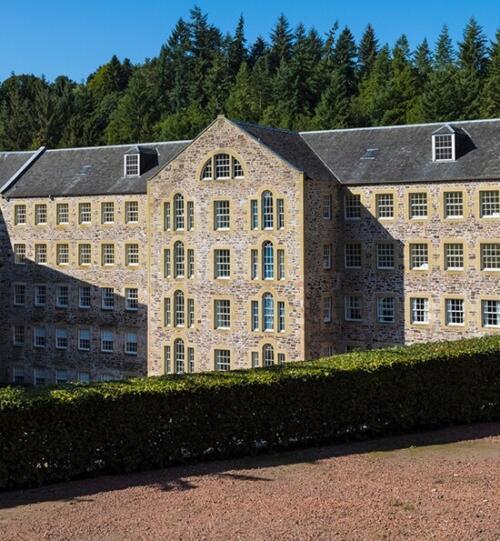
Walks and ways to travel around
New Lanark is nestled in the green Clyde Valley in central Scotland, less than an hour from Glasgow and Edinburgh by car, and with easy public transport links available by coach, train, and bus.
The surrounding area of New Lanark is wonderful to explore on foot with its spectacular waterfalls, scenic woodland walks, and teeming wildlife. Follow the Falls of Clyde walking route, starting from the heritage site, and passing a succession of waterfalls including the magnificent Cora Linn and Dundaff Linn as you head up into a wooded gorge before descending through undulating fields and tranquil woodland.
The Clyde Walkway takes you over 40 miles from Glasgow to Lanark. It’s a low-level waymarked route on well-defined paths, and doesn’t rise above 200 m so it’s suitable for walkers of any age and ability.
More information
UNESCO designation
New LanarkVisiting the area
Glasgow & Clyde Valley Glasgow iCentre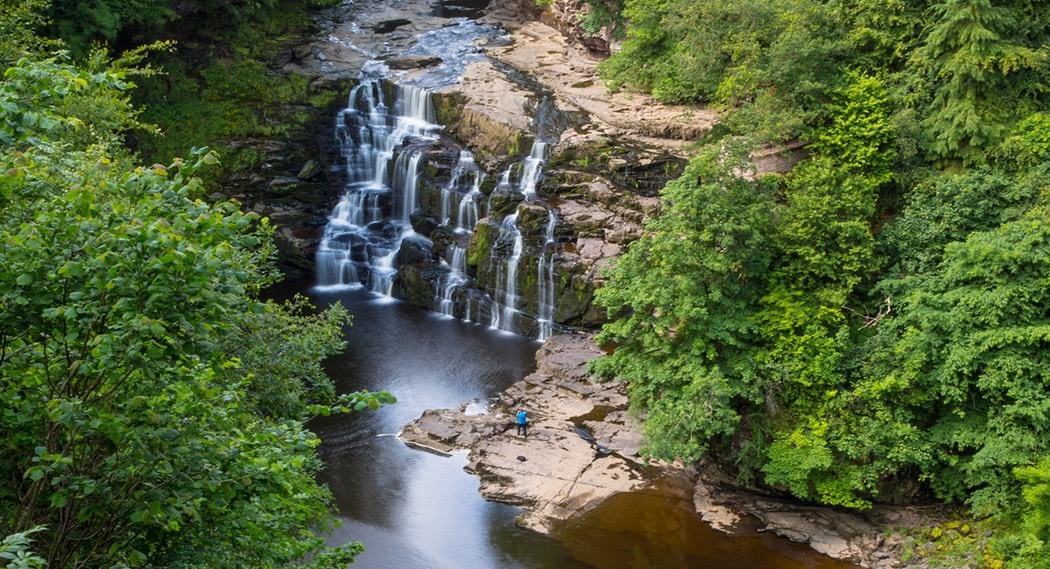

Frontiers of the Roman Empire, The Antonine Wall UNESCO World Heritage Site
Where to start
The Antonine Wall marked the northern frontier of the Roman Empire in the second century. Stretching 60 km from coast to coast, this mighty fortification was built on the orders of Emperor Antoninus Pius in 142 AD.
It formed part of the ‘Roman Limes’ - the perimeter of the Roman Empire spanning 5,000 km from Britain’s Atlantic coast, through Europe and beyond, as far as the Middle East and North Africa.
The Scottish portion of the frontier spans the central belt of Scotland, from Old Kilpatrick on the Firth of Clyde to Bo’ness on the Firth of Forth, and while much of it now runs through private property, you can see its best-preserved remnants at many publicly accessible locations. When it was in use, this sophisticated military installation was lined with 17 forts, manned by 7,000 soldiers, and served as a vital defence and communications link for the Romans.
Towns and cities to base yourself in
Why it’s special
Although built primarily for defence, the wall was a technically advanced construction that drew on hundreds of years of Roman engineering experience. It was fully built, manned and abandoned within a generation, which is no mean feat considering its size.
The Romans worked on a grand scale and made their presence well-known – we can see this today through the traces of stone bathhouses, underfloor heating, the Military Way, and massive earthwork banks.
The troops who constructed it have left behind the most comprehensive and spectacular range of distance slabs found anywhere on the frontier, telling stories of battles, power and religious beliefs.
The wall was home not just to the soldiers, but to their families, merchants and other civilians from all over the Empire – not just Italy, but Syria, the Netherlands, Bulgaria and Germany.
We even know that they managed to maintain impressive contact with the rest of the Empire - artefacts found on the wall and now exhibited in the Hunterian Museum and the National Museum of Scotland reveal wine and pottery was imported from France, and olive oil and figs were brought north by boat, giving a taste of home for soldiers based far away.
Type of designation
UNESCO World Heritage Site
Time required
At least 2 days
What to do during your time
Things to do
The Hunterian Museum
Visit the permanent gallery, The Antonine Wall: Rome’s Final Frontier, which showcases an amazing collection of sculptured distance slabs and other Roman artefacts recovered from the wall.
Find out more about the Hunterian Museum.
Antonine Wall Guided Tours
One of the best ways to learn about the Antonine Wall is to take a guided tour with one of the designation’s knowledgeable guides. Throughout the year events are run at the various wall locations including Rough Castle and Callendar Park.
Find out more about Antonine Wall guided tours and events.
Rough Castle
Rough Castle was one of 16 forts which once lined the Antonine Wall. The smallest but best-preserved of the forts, visitors can clearly make out the ditches, ramparts, and lilia pits which made these structures a force to be reckoned with.
Find out more about Rough Castle.
Kinneil Museum
Explore 2,000 years of history at the small museum housed inside a 17th century stable block. Learn the story of the town of Bo'ness which was built on Roman remains, and the Kinneil Estate, with its connections to famous names from Scottish history including Mary Queen of Scots and James Watt. From here it’s just a short walk to the estate’s section of the Antonine Wall and the remains of a small fortlet.
Find out more about Kinneil Museum.
Watling Lodge
The best-preserved section of the Antonine Wall ditch is visible from both the east and west of Watling Lodge along Tamfourhill Road in Falkirk. Measuring 8 km, the ditch remains almost the same depth as when originally built, offering the chance to appreciate the massive scale.
Find out more about Watling Lodge.
Carron Glen
This Scottish Wildlife Trust nature reserve is found near Falkirk on the banks of the River Carron, which runs through a steep wooded gorge filled with native oak and ash trees. A vital crossing point which was patrolled during Roman times, the glen is now a prime birdwatching spot and an ideal place to enjoy wildflower blooms and spectacular autumnal colours.
Find out more about Carron Glen.
Food and drink
You can work up an appetite exploring the Antonine Wall and its nearby attractions. Luckily there are plenty of places where you can stop for a coffee or a bite to eat, as well as farm shops and markets where you can pick up local produce to take home.
- Dumbarton Market — NeighbourFood
- Mannerstons Café and Farm Shop
- The Atrium Café Restaurant
- The Boathouse, Auchinstarry
- The Café at Canada Wood
Accommodation
There’s plenty to see and do in central Scotland besides the Antonine Wall. Home to castles, lochs, ancient battles sites and the iconic Kelpies, not to mention some gorgeous scenery, it’s a fantastic destination to spend a weekend or longer. Choose from a fantastic range of accommodation, from city-centre boutique hotels to cosy timber eco cabins amid unspoiled countryside.
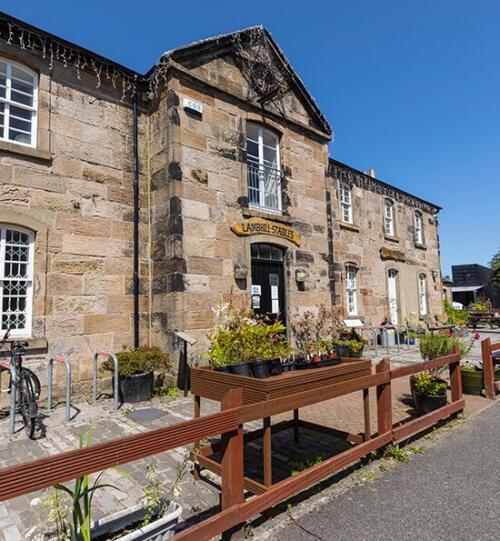
Local tips
Look out for the new steel sculpture of a Roman soldier’s head at the Antonine Wall section at Croy Hill, looking out across Auchinstarry to the Campsie Hills. This part runs along the John Muir Way, starting a great walk over Croy Hill (site of a Roman fort and a section of rock-cut ditch that defeated even the Romans) and onto Bar Hill fort.
The sculpture represents the soldiers who were stationed on the wall as guards, looking out to what they deemed as ‘barbarian’ territory. A local competition named it Silvanus, after the God of the forests and woodlands.
Walks and ways to travel around
It’s easy to discover the Antonine Wall with excellent public transport links including rail. There’s also an extensive cycle-path network.
You can also organise a private guided bike tour with Ricky’s Bikes Bicycle Tours. Why not opt for the UNESCO Heritage tour to see the Roman fort at Cramond and the Forth Bridge from South Queensferry? Or design your own custom tour with shuttle transport for you and your bike.
You can explore on the water with the Forth and Clyde Canal running parallel alongside much of the wall. If you or someone you know has special needs, you can arrange a free-of-charge barge trip along the canal from Falkirk with Seagull Trust Cruises, a charity run by volunteers.
More information
UNESCO designation
Antonine WallVisiting the area
Loch Lomond, The Trossachs, Stirling & Forth Valley Glasgow & Clyde Valley Stirling iCentre Glasgow iCentre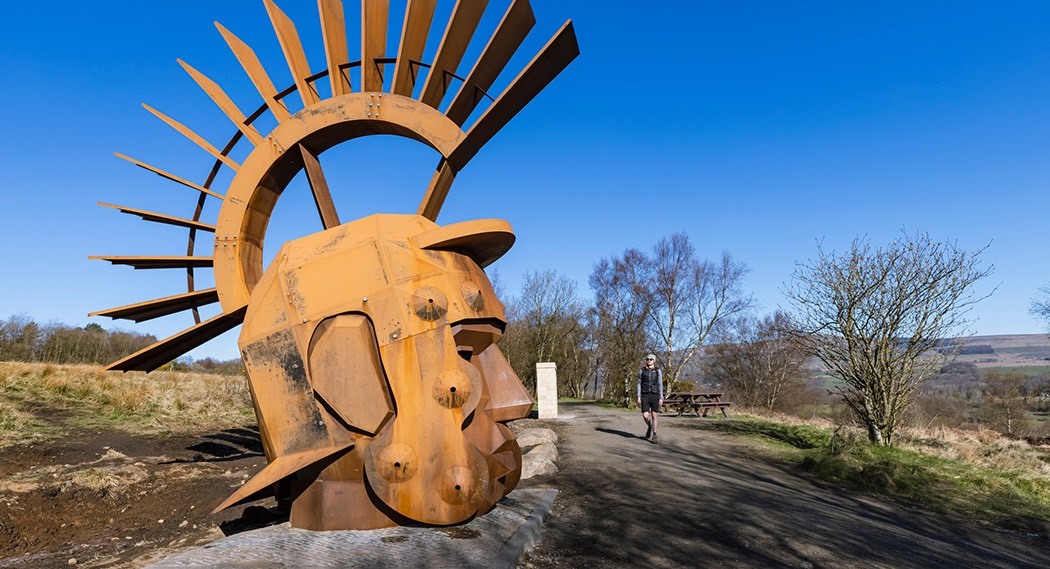
Where next on the UNESCO Trail?
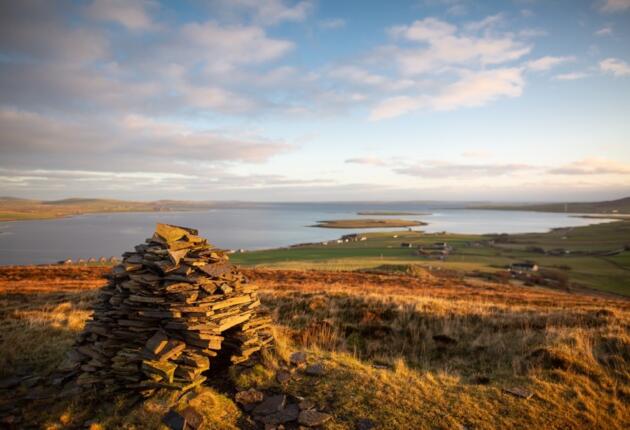
UNESCO Sites to Explore in Scotland's Northern Isles
Explore the two UNESCO sites in Scotland's northern isles. Shetland is a recognised Global Geopark, while Orkney is home to the World Heritage Site of Heart of Neolithic Orkney.
View Journey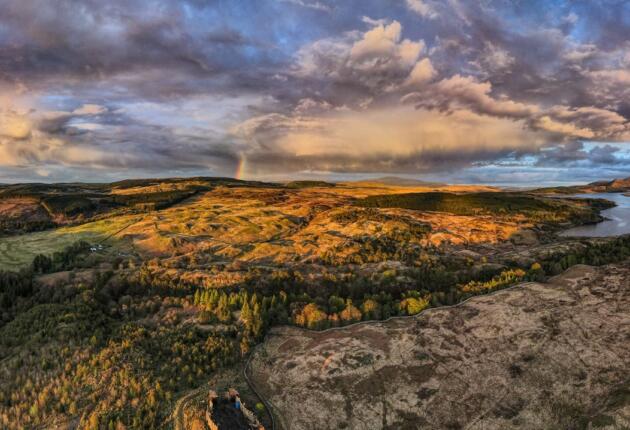
Explore South Scotland's UNESCO Site
Travel easily to the Galloway and Southern Ayrshire Biosphere. Why not begin your trip at one of the biosphere communities where you’ll be given a warm welcome and information to help you explore?
View Journey
